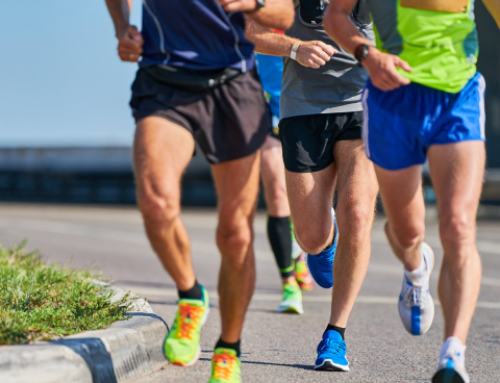Iliotibial Band Syndrome [ITBS]
Dan Graham, assistant athletic trainer for the University of Georgia track and field team, lays out some essential 411 about ITBS and how to treat it.
Your iliotibial band is a band of tissue that extends from the outside of your pelvis, over your hips, to the outer side of your shin bones, just below the knee joints. It connects your glutes to your tibias and stabilizes your knees during running. According to Graham, the iliotibial band can become irritated and inflamed over time, resulting in Iliotibial Band Syndrome [ITBS], a.k.a. Iliotibial Band Friction Syndrome (ITBFS).
Causes and Symptoms
Graham says runners commonly suffer from ITBS due to continuous rubbing of the band against the knee joint, and from the repeatedly flexing and extending knee. “And a lot of it has to do with the surfaces you’re running on,” he says, noting that ITBS can result from genetics as well.
Running on uneven or sloped surfaces can be a catalyst for IT Band inflammation. “Most [roads] are sloped so that water will run off,” Graham says. “If you go out and run on the road a lot, and you’re running on the same slope all the time…you’re putting excess stress and strain [on one side more than the other], and over time it just wears and wears until it gets painful.”
Athletes suffering from ITBS usually experience pain or stinging above, below or at the knee joint, or pain and swelling in the thigh. “It just gets inflamed,” Graham says, “[and] it gets really annoyingly painful at some points.”
Treatment and Recovery
The first step to treating ITBS is to report the injury before it worsens. “We hope [athletes] report it to us before it becomes so painful that it’s interrupting their normal everyday activities,” Graham says. “[Then] we want to work on minimizing the pain.”
According to Graham, anti-inflammatory medicine and ice are used to reduce the inflammation. Electric stimulation, foam roll stretching or massage will also minimize the pain, but the key component is rest. “They’re not going to be out running,” he says. “They may be able to do some cross-training activities like using the pool—where they’re not doing a lot of weight bearing [leg movements]—just until we get that pain [and] inflammation under control.”
Once the injury is subdued, the focus turns to flexibility and strength training to prevent it from recurring. “A general strengthening program for your hips, glutes, groin muscles and quads [will] make sure there [are] no imbalances from one side to another,” Graham says, “and that all the muscle groups are working together so that all the stress isn’t on one area.”
RECOMMENDED FOR YOU
MOST POPULAR
Iliotibial Band Syndrome [ITBS]
Dan Graham, assistant athletic trainer for the University of Georgia track and field team, lays out some essential 411 about ITBS and how to treat it.
Your iliotibial band is a band of tissue that extends from the outside of your pelvis, over your hips, to the outer side of your shin bones, just below the knee joints. It connects your glutes to your tibias and stabilizes your knees during running. According to Graham, the iliotibial band can become irritated and inflamed over time, resulting in Iliotibial Band Syndrome [ITBS], a.k.a. Iliotibial Band Friction Syndrome (ITBFS).
Causes and Symptoms
Graham says runners commonly suffer from ITBS due to continuous rubbing of the band against the knee joint, and from the repeatedly flexing and extending knee. “And a lot of it has to do with the surfaces you’re running on,” he says, noting that ITBS can result from genetics as well.
Running on uneven or sloped surfaces can be a catalyst for IT Band inflammation. “Most [roads] are sloped so that water will run off,” Graham says. “If you go out and run on the road a lot, and you’re running on the same slope all the time…you’re putting excess stress and strain [on one side more than the other], and over time it just wears and wears until it gets painful.”
Athletes suffering from ITBS usually experience pain or stinging above, below or at the knee joint, or pain and swelling in the thigh. “It just gets inflamed,” Graham says, “[and] it gets really annoyingly painful at some points.”
Treatment and Recovery
The first step to treating ITBS is to report the injury before it worsens. “We hope [athletes] report it to us before it becomes so painful that it’s interrupting their normal everyday activities,” Graham says. “[Then] we want to work on minimizing the pain.”
According to Graham, anti-inflammatory medicine and ice are used to reduce the inflammation. Electric stimulation, foam roll stretching or massage will also minimize the pain, but the key component is rest. “They’re not going to be out running,” he says. “They may be able to do some cross-training activities like using the pool—where they’re not doing a lot of weight bearing [leg movements]—just until we get that pain [and] inflammation under control.”
Once the injury is subdued, the focus turns to flexibility and strength training to prevent it from recurring. “A general strengthening program for your hips, glutes, groin muscles and quads [will] make sure there [are] no imbalances from one side to another,” Graham says, “and that all the muscle groups are working together so that all the stress isn’t on one area.”











